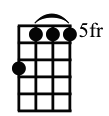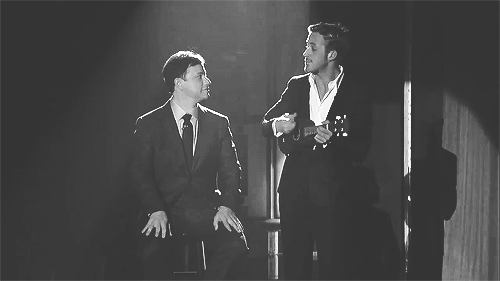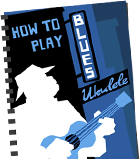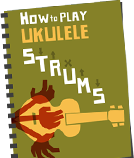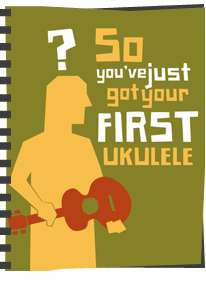 When I got my first ukulele, I was completely clueless. This was in those dark, long forgotten days before the internet had been discovered. I didn’t even realise that the strings weren’t supposed to go thickest to thinnest and restrung it.
When I got my first ukulele, I was completely clueless. This was in those dark, long forgotten days before the internet had been discovered. I didn’t even realise that the strings weren’t supposed to go thickest to thinnest and restrung it.
But you can save yourself from the social disgrace I experienced. I’ve put together a free mini-ebook covering the basics that every first time uke owner needs to know. Here’s what it contains:
Five Things to Know
Five Chords to Learn
Five Patterns to Strum
Five Songs to Play
Five Websites to Visit
Five Things to Get Free
Five Things to Buy
Five Videos to Watch
Five YouTube Channels to Subscribe to
You can download it free by clicking here:
So You Just Got Your First Ukulele (PDF)
And get playing by following the beginner ukulele lessons.
Merry Christmas, Chanukah Sameach, Happy Holidays, Io Saturnalia and Happy Holidays!
If you’re after some Christmas music and you’re as Spotify user here’s my Christmas Ukulele playlist. Or if you’re sick of Christmas music my playlist of ukulele selections from 2014 including lots of Uke Hunt favourites and a few surprises (Neil Young being the most surprising).
That’s it from me for this year (other than the ebook for new ukers). I’ll be back at the end of January 2015 (year of the F6 chord).
If you can’t bear to be without a steady stream of uke, I’ll be posting bits and pieces on Tumblr, UkeToob and on Twitter.
New Releases
– New book from Lil’ Rev Fiddle Tunes for Ukulele.
– Christmas Carols for Ukulele Orchestra tab book.
– Experimental bari-uker, Kevin Hufnagel has released the album Ashland and a pair of beautiful singles The Murderer’s Tracks and The Weather was Wrong.
– Ben Rouse’s The Merry Uke Man.
– Stefanie Santana’s I Admit I Am Glad.
Pictures
– Museu Cavaquinho‘s display of painted cavaquinhos included this one.
– Ukosaurous Rex.
– University of Hawaii’s collection of ukulele ads.
– Joseph Jung’s ukulele class.
Videos
– Roy Smeck: Wizard of the Strings documentary. (Thanks to Peter)
– Ukulelia investigates Nee Wong.
– 30 minute medley of all Beatles singles
Nick Thorburn – Serial Theme (Tab)
I had to do this tab to celebrate the finale of the first series of Serial. The plinkiness of it was just dying to be uked. To keep it extra-plinky it’s played right up the neck.
Links
Buy it on iTunes
Listen to Serial
Bonus: Jordan, Jesse, Go! Theme
The Free Design – Love You (Tab)
While I’m on podcast themes, here’s my favourite. The twee as fuck theme tune to Jordan, Jesse, Go! by The Free Design.
Links
Matt Kresling – Year of the Dog (Tab)
The travelogue of Matt Kresling and his ukulele’s circuitous trip to Madagascar is my favourite series on YouTube. Whenever a new episode crops up it’s a little treat. And there was a new one this week so it seems like the perfect time to put up my take on the show’s theme tune Year of the Dog.
The picking is all thumb and two finger style. I think Matt uses D-tuning for his version. But I’ve just gone with C-tuning.
If you’re looking for a travel doc to watch over the holidays I highly recommend it. Here’s the series trailer:
Links
Madagascar Journals playlist
Matt Kresling on YouTube
Matt Kresling on Bandcamp
Time for the annual Uke Hunt Christmas time-waster.
– Grab a pen and paper
– Display knowledge.
– There might be spoilers in the comments.
– Check the answers here (no peeking).
– Return in triumph or despair and share you score in the comments.
If you’re reading by email or feed reader you may need to click through to the post to see everything.
Name the Chord
Name the K
Which brand, beginning with K, makes these ukes? (Click for a bigger version)
6.
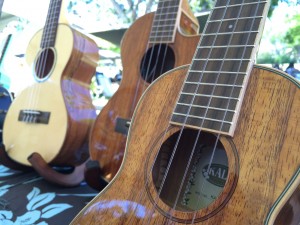
By Ryan Ozawa
7.
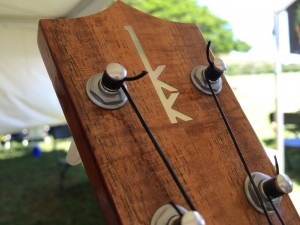
By Ryan Ozawa
8.

By Ryan Ozawa
9.

By componentgeek
10.
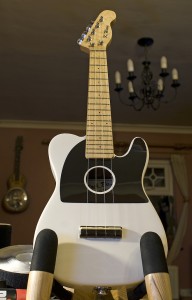
By philip hay
Name the Cover
Who first released the songs these ukulele orchestras are covering?
11. Durham Ukulele Orchestra
12. Otley Ukulele Orchestra
13. Ukulele Turin Orchestra
14. West Cork Ukulele Orchestra
15. The Ukulele Club
Name the Actor – GIF edition
Which actor is playing/crotch-spinning the ukulele in these gifs
16.
a) Zooey Deschanel
b) Emma Stone
c) Katy Perry
d) Shailene Woodley
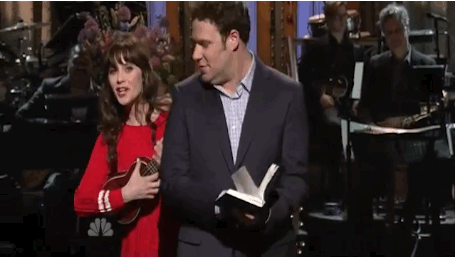
17.
a) Doris Day
b) Diana Dors
c) Marilyn Monroe
d) Greta Garbo
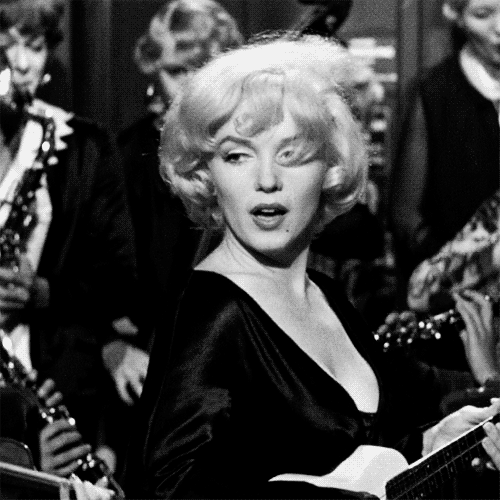
18.
a) Peter Dinklage
b) Alfie Allen
c) Charles Dance
d) Tywin Lannister
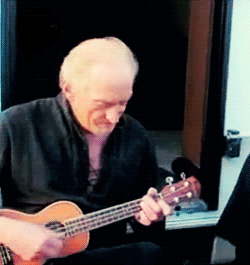
19.
a) James Franco
b) Ryan Gosling
c) Shia LaBeouf
d) Leonardo di Caprio
20.
a) Christopher Walken
b) Christophe Waltz
c) Chris Pratt
d) Christopher Guest

Name the Lyric
Which song – oft covered on ukulele – are these lyrics from?
21.
See her walking down the street / Now I ask you very confidentially
22.
Though the days are long / Twilight sings a song / Of a happiness that used to be
23.
Somewhere in her smile she knows / That I don’t need no other lover / Something in her style that shows me
24.
Ukulele small and fierceful / Ukulele brave and peaceful / You can play the ukulele too, it is painfully simple
25.
Yeah it’s pretty clear, I ain’t no size two / But I can shake it, shake it like I’m supposed to do / ‘Cause I got that boom boom that all the boys chase / All the right junk in all the right places
Name the Theme Tune
This is the theme tune to which…
26. …movie franchise?
27. … US sitcom?
28. … pig-killing mobile game?
29. …detective TV show?
30. … animated TV show?
Check the answers here
Past Quizzes
Ukulele Quiz 2013
Ukulele Quiz 2012
Ukulele Quiz 2011
Ukulele Quiz 2010
Ukulele Quiz 2009
Carrie Hope Fletcher – Somewhere Only We Know (Chords)
When I mentioned I was doing this song to Uke Hunt’s US Cultural Affairs Correspondent her reaction was, “Somewhere Only We Know?! Isn’t it several years too late for that song?” So I feel I should explain. Last year Lily Allen did a cover for a Christmas advert. The ad was everywhere, the song was everywhere, it went to number 1. I thought that was the end of it but it’s been cropping up again this year as Christmas song even though there’s nothing particularly Christmassy about it (other than containing a Jesus4 chord). But it’s a nice song so I’m not complaining.
I’ve written up the chords for Carrie Hope Fletcher’s version. Partly because it’s dead easy and a great place to start if you’re looking to get into fingerpicking. And partly because that makes this the first time I’ve featured separate a brother and sister ukulele songs.
To play along with the video tune up by one fret or put a capo on the first fret.
Picking Pattern
The picking is a thumb and two finger pattern. The full pattern goes like this:
Thumb picks C
Index picks E
Middle picks A
Thumb picks C
Index picks E
Middle picks A
Thumb picks C
Index picks E
So you go up the top three strings in order twice, then just the C- and E-strings. Do that once for every chord.
Here’s how it looks slow then up to speed:
And here it is in tab form:
Links
The original version on iTunes
The Lily Allen version on iTunes
Carrie Hope Fletcher on YouTube
More Christmas tabs and chords




